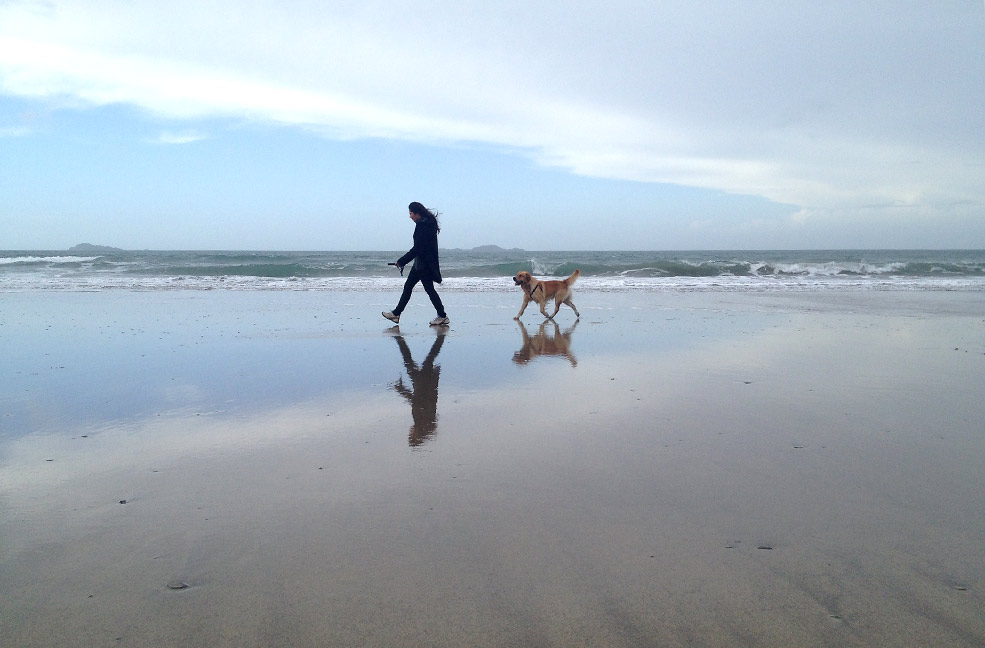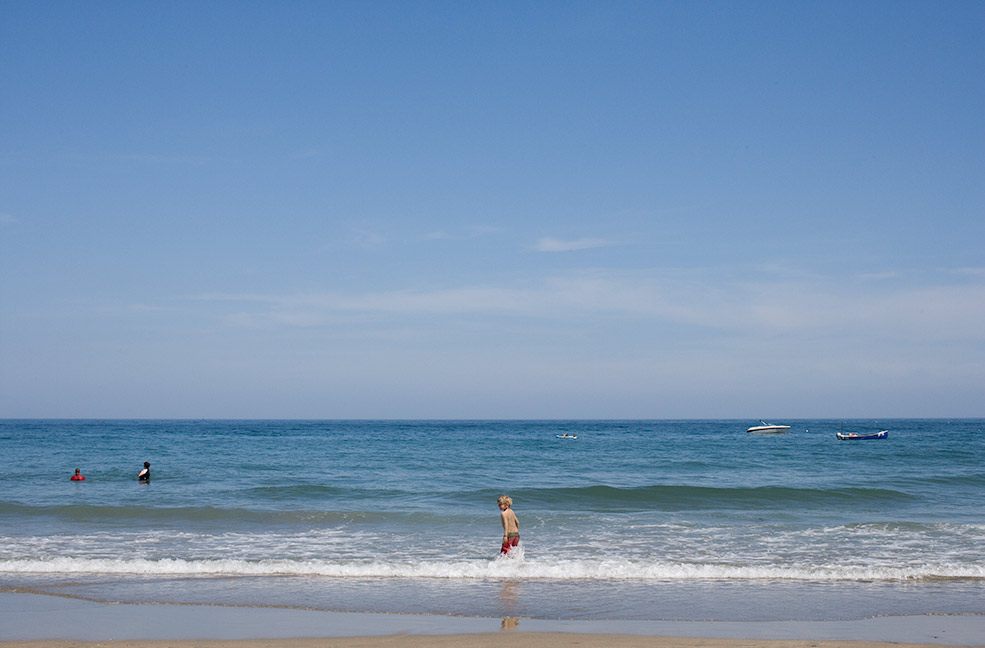Home to sandy beaches, dramatic clifftops, bustling seaside towns, sleepy villages and unspoilt rolling countryside, Dorset really is a jewel within the British Isles. Much-loved by the Victorians who holidayed on its golden shores to take in the wholesome sea air, it has been a favourite destination for centuries.
Today, it’s a beautiful county to escape to, with a plethora of fascinating places to discover for yourself. From natural rock formations to ancient monuments, here are some of the top landmarks to visit while exploring Dorset.
Durdle Door, West Lulworth

One of the most photographed landmarks in Dorset, this iconic and majestic cove is utterly unique with its incredible 200 foot-tall limestone archway, created about 10,000 years ago when the sea tunnelled its way through the stone. Situated on the Lulworth Estate, it forms part of the Jurassic Coast and is accessed by both pathway and 143 steps over the hill from Lulworth Cove or down from the car park – or alternatively you can take the longer way down through the fantastically named Scratchy Bottom that’s a little gentler and often quieter.
As you can imagine, Durdle Door is a particularly popular spot, so we recommend visiting at golden hour for a sunset with a difference - if you time it just right the sun is captured perfectly within the arch, creating a wonderfully romantic setting. It’s also a wonderful beach for rock pooling and swimming, or simply lying back and soaking up the stunning views. It’s also dog friendly all year, making it perfect for days out with your furry friend.
Gold Hill, Shaftesbury

Shaftesbury has to be one of the most beautiful towns in England, as well as one of the highest and oldest. Filled with thatched cottages and cobbled streets, quaint tea rooms and quirky independent shops, Gold Hill has to be the most recognisable of its streets, made famous by the ‘Hovis’ advert that depicts a boy on a bike delivering loaves of bread.
Stand at its summit and admire this beautiful, Insta-worthy street with Blackmore Vale as its backdrop (or walk up it if you’re feeling particularly energetic) before taking a peek in the Gold Hill Museum that has an award-winning cottage garden. Afterwards, pay a visit to Shaftesbury Abbey Museum and Gardens to delve into the history of this fascinating town which has been in existence since Saxon times.
Old Harry Rocks, Studland
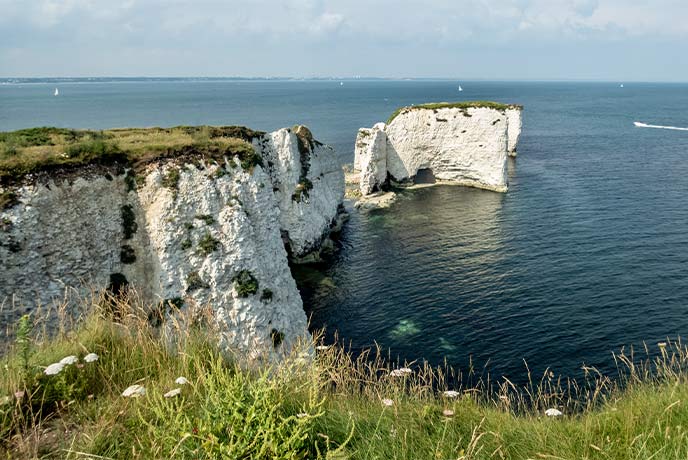
Situated on Handfast Point at the southern end of Studland Bay lies this incredibly impressive landmark. The chalky columns are known collectively as Old Harry Rocks, but Old Harry himself is a single chalk stack that stands further out to sea. He was once accompanied by another stack known as Old Harry’s Wife, but sadly she tumbled into the sea back in 1896.
Created thousands of years ago when Old Harry and the Needles on the Isle of Wight were once linked, there’s lots of theories as to where the name came from, whether from a local pirate named Harry Paye or the devil himself. Either way, it’s a stunning stretch of the South West Coast to explore from Studland to Handfast Point, with wide grassy areas to sit and relax, or enjoy a picnic. Dogs are welcome here but should be kept on a lead due to the cliffs. Alternatively, get out on the water for a unique view – a kayaking tour is a brilliant way to get about and you might see the resident seals too!
Weymouth’s historic harbour

A stroll around the fishing harbour of Weymouth is a great way to while away an afternoon, passing the colourful painted buildings, independent shops and welcoming pubs. Don’t be fooled by its tranquil vibe today though – ships once sailed from here to fight in the Spanish Armada in 1588, while it was one of the main battle sites during the Civil War in the 17th century (there’s even a cannonball still stuck in a building!). It was also a launch point for troops heading to the D-Day landings at the end of World War II.
Today it’s chock-full of fresh seafood and mouth-watering fish and chips (we particularly love Michelin restaurant Catch), so make sure to take your appetite with you, while if you visit in early September you’ll catch the annual Dorset seafood festival Seafest.
Lyme Regis, the Jurassic Coast
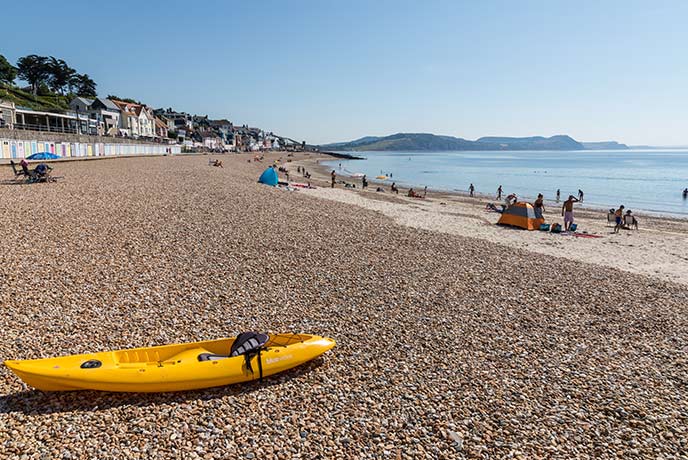
Lyme Regis was once home to real-life heroine Mary Anning, a local palaeontologist who collected incredible fossils found on the beaches around the town. From a poor background with little to no education, she’s considered to be one of the leading figures in the study of the Jurassic Coast’s fossils – at just 12 years old, she discovered an ichthyosaur (an ancient reptile meaning ‘fish lizard’), fuelling crowds of people to descend on Lyme Regis and fossil hunt for themselves.
Today, you can still find fossils along the coast, especially between Lyme Regis and Charmouth, so why not spend an afternoon exploring, making sure to keep an eye on the tide and keeping away from the base of the cliffs. If you’re really keen, you can book yourself onto a fossil hunting tour through the Lyme Regis Museum.
Golden Cap, Bridport
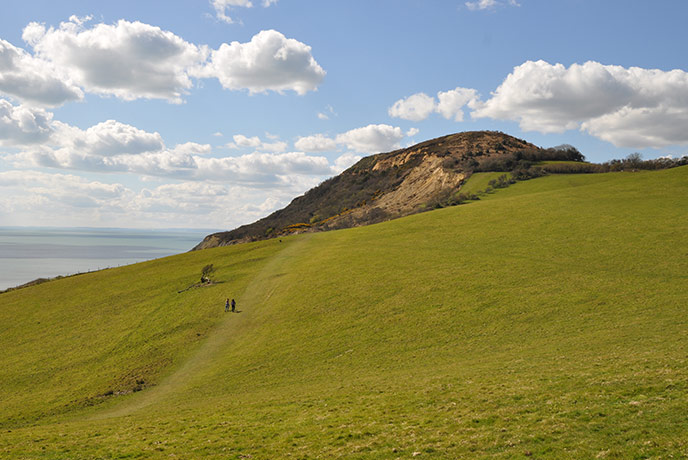
This beautiful landmark makes for one of the best walks in Dorset, starting out from nearby Seatown along the South West Coast Path (or you can opt for our easy route!). The highest point on the south coast of England at 191 metres high (627 feet), it’s a steep climb but well worth it for its stunning and far-reaching views.
Golden Cap lies on a National Trust estate and includes beautifully tranquil woodland, meadows and a ‘lost’ village that’s mentioned in the Domesday book in 1086. Today, the only clue to the village’s existence is the ruins of a 13th century chapel. After your walk, head into Seatown and pop in to The Anchor Inn for a drink and a bite to eat.
Corfe Castle, Nr Wareham
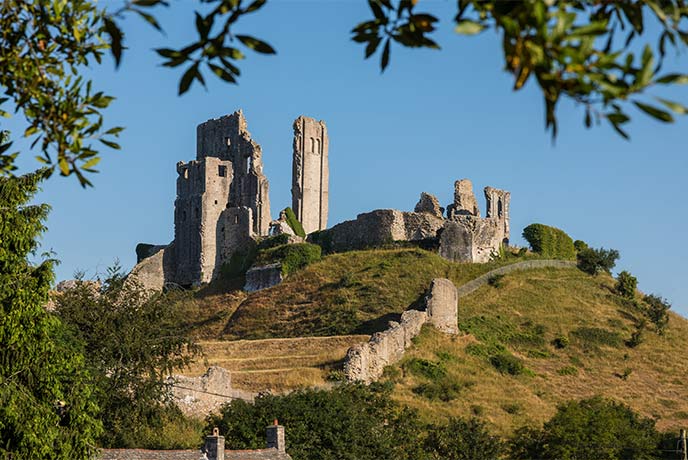
This majestic ruin lies on its own summit with romantic views across the Isle of Purbeck. Founded by William the Conqueror over 1,000 years old, Corfe Castle played an important role as a royal palace and a fortress, specifically during the English Civil War as a Cavalier stronghold and supporter of King Charles I. Today it lies in ruin after being destroyed in 1646, but it still offers a fascinating glimpse into the past with an audio tour to guide you through your visit.
After you’ve delved into the castle’s history, there’s a tea room with picnic area for food and drinks, as well as a book shop to pick up your next page turner and mementos. Afterwards, visit the neighbouring site of Nine Barrow Down which is home to Stone Age burial mounds and offers fabulous views back over the castle.
Brownsea Island, Poole

Lying in Poole Harbour, Brownsea Island is one of a number of islands to be scattered across the bay, and is just over 1.5 miles wide. A unique, unspoilt nature reserve that’s only accessible by ferry from Poole Quay or Sandbanks, it’s famous for its red squirrel population that thrive in this protected spot.
In addition, there’s heathland, woodland and a peaceful lagoon that’s vitally important for migratory birds that live here during the winter and summer months. You can explore the island by yourself or take advantage of the daily guided tours, with buggy tours available for those with limited mobility (it’s best to book these in advance). There’s a visitor centre to delve into the history of the island and a harbourside café and gift shop too.
Kingston Lacy, Wimborne Minster
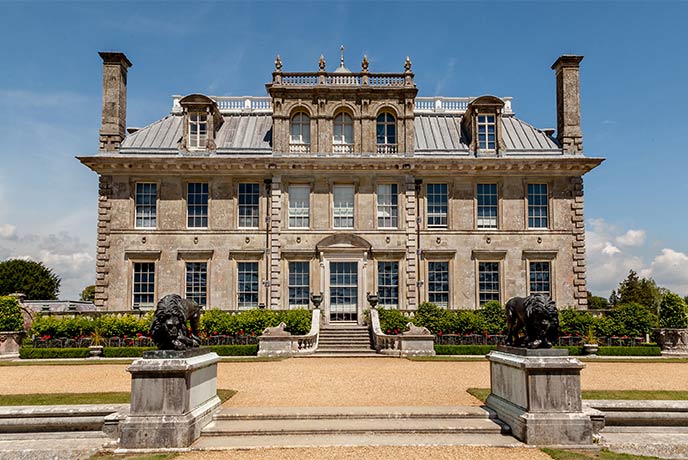
Nestled in the countryside in Wimborne Minster, Kingston Lacy is an extraordinary 17th century mansion, completely reimagined during the 19th century by William John Bankes into a lavish, Venetian-inspired home, jam-packed with hugely important works of art by the likes of Rubens, Van Dyck, Titian and Brueghal, as well as the impressive Egyptian Philae obelisk, whose inscriptions were fundamental in the deciphering of Egyptian hieroglyphics in the early 19th century. What makes this even more surprising is that William John undertook all this work whilst in exile, and never got to see the finished house in all its glory for himself.
Today, you can explore this incredible 8,500-acre estate, that’s also home to extensive and beautiful gardens that includes a fernery, kitchen garden, Japanese-inspired garden and dappled woodland. Further afield lie acres of parkland, home to Red Ruby Devon cattle and rare breed Portland sheep. Take a break at the café and peek in the National Trust shop whilst little ones let off steam in the two play areas – one in the woodland and one in the kitchen garden.
Cerne Giant, Cerne Abbas
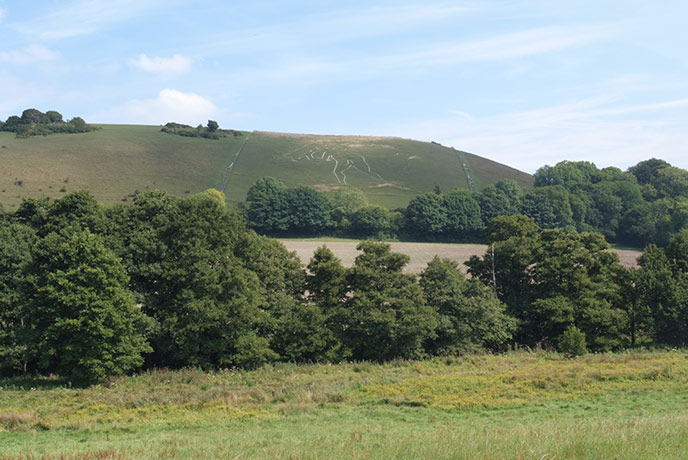
Set on the chalky rolling hills around the pretty village of Cerne Abbas, the Cerne Giant is a huge, 180 foot-tall giant figure sculpted into the hillside. Discussed and theorised (and giggled) over for centuries, there’s no concrete evidence as to when or why it was built, with theories ranging from being a symbol of fertility to a mockery of Oliver Cromwell, but after extensive analysis in 2021, it’s believed to have been constructed around the late Saxon period.
Above the giant lies an Iron Age earthwork enclosure, still used today for May Day celebrations, while the surrounding grassland is an important site for chalk downland plants and insects such as the marsh fritillary butterfly. The giant is best viewed from the Giant’s View car park, or you can walk the quarter mile from the village up to the Giant’s feet. Cerne Abbas itself is a beautiful village with gorgeous stone cottages, an abbey and a well, along with some great pubs.
Lulworth Cove, West Lulworth
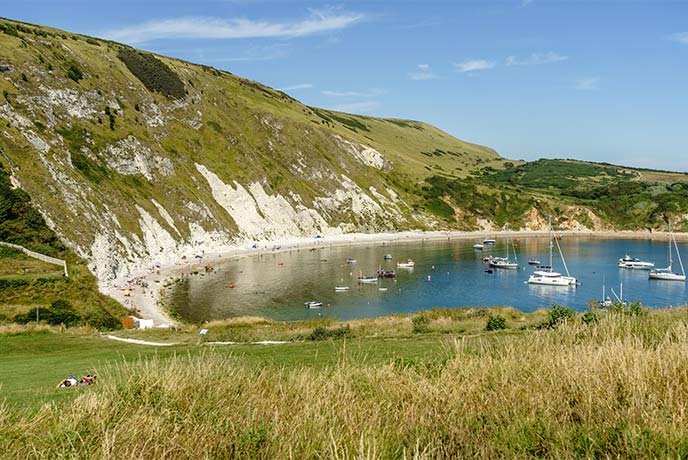
Dorset is blessed with some truly beautiful beaches, but none are quite as idyllic as the iconic Lulworth Cove. Famed for its near-circular shape and unique geology, this paradisiacal cove is one of the most jaw-dropping landmarks in the UK, let alone Dorset.
Swim in the crystalline waters, lounge on the pebbly beach with an ice cream, or take a walk through history as you explore Lulworth Crumple and Stair Hole, two of the impressive formations found at the cove. An all-terrain scooter can be hired for the day too, allowing everyone to access this stunning example of natural history.
Portland Bill Lighthouse, Portland

The distinctive red and white striped lighthouse of Portland Bill has to be one of the most recognisable lighthouses in Britain, and climbing Bill’s 153 steps to its top will give you truly epic views of the Dorset coastline and out to sea over the glistening rocks and crashing waves. Down at land level it has an excellent visitor centre where you can learn all about the Isle of Portland.
The island is the southernmost point of the Jurassic Coast and joined to the mainland by Chesil Beach. Four miles long and a mile and a half wide, it’s a natural paradise for wildlife as well as a great location for outdoor activities such as rock-climbing, abseiling, diving and sailing. If you’re after a more leisurely pace, there’s a fantastic 9.5 mile walk following the South West Coast Path along the dramatic cliff tops around the island.
Hardy Monument, Portesham
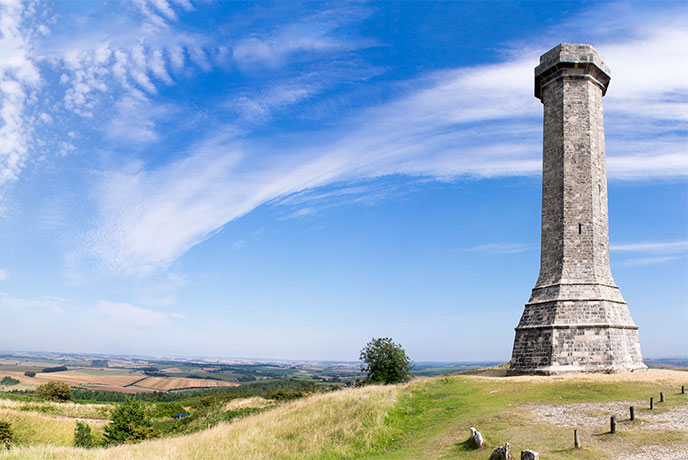
Standing proud above the sweeping Dorset countryside, Hardy Monument provides a truly impressive tribute to Vice-Admiral Hardy - not to be confused with the much-loved author! The towering monument was built in 1844 to commemorate the life of the acclaimed Flag Captain of HMS Victory at the Battle of Trafalgar. Famously, Sir Thomas Hardy held Napoleon in his arms as he died, causing the memorable final words: “Kiss me, Hardy!”
You’ll find a National Trust car park at the monument, making this a wonderfully easy place to get to. Why not pack up a picnic and take in the surrounding views at your own pace, it is after all a pretty spectacular spot for lunch.
Feeling inspired to discover all the amazing spots in Dorset? Explore our welcoming cottages and start planning all the unique things you can do on your holiday.


